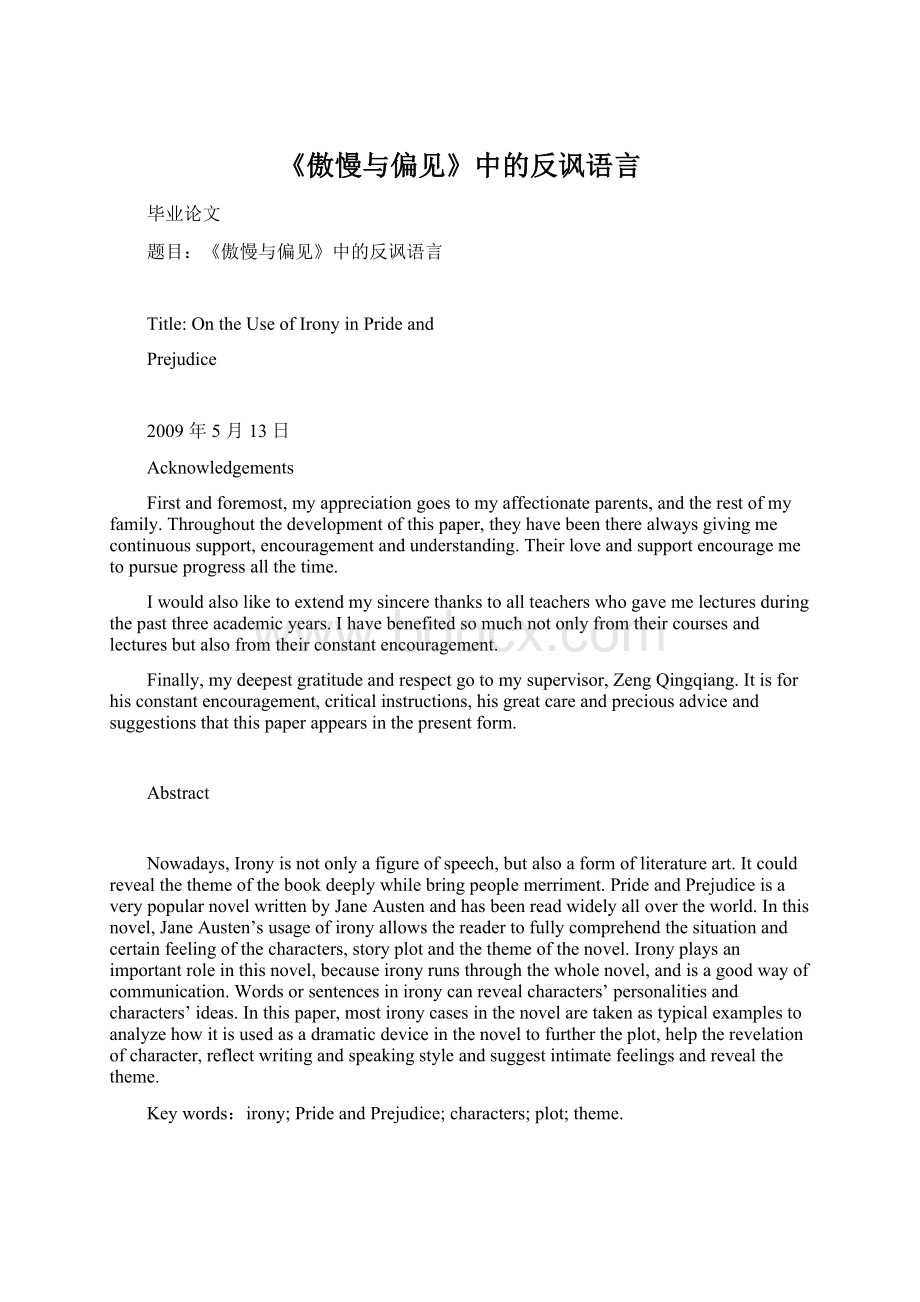 《傲慢与偏见》中的反讽语言.docx
《傲慢与偏见》中的反讽语言.docx
- 文档编号:4092908
- 上传时间:2022-11-27
- 格式:DOCX
- 页数:14
- 大小:35.22KB
《傲慢与偏见》中的反讽语言.docx
《《傲慢与偏见》中的反讽语言.docx》由会员分享,可在线阅读,更多相关《《傲慢与偏见》中的反讽语言.docx(14页珍藏版)》请在冰豆网上搜索。

《傲慢与偏见》中的反讽语言
毕业论文
题目:
《傲慢与偏见》中的反讽语言
Title:
OntheUseofIronyinPrideand
Prejudice
2009年5月13日
Acknowledgements
Firstandforemost,myappreciationgoestomyaffectionateparents,andtherestofmyfamily.Throughoutthedevelopmentofthispaper,theyhavebeentherealwaysgivingmecontinuoussupport,encouragementandunderstanding.Theirloveandsupportencouragemetopursueprogressallthetime.
Iwouldalsoliketoextendmysincerethankstoallteacherswhogavemelecturesduringthepastthreeacademicyears.Ihavebenefitedsomuchnotonlyfromtheircoursesandlecturesbutalsofromtheirconstantencouragement.
Finally,mydeepestgratitudeandrespectgotomysupervisor,ZengQingqiang.Itisforhisconstantencouragement,criticalinstructions,hisgreatcareandpreciousadviceandsuggestionsthatthispaperappearsinthepresentform.
Abstract
Nowadays,Ironyisnotonlyafigureofspeech,butalsoaformofliteratureart.Itcouldrevealthethemeofthebookdeeplywhilebringpeoplemerriment.PrideandPrejudiceisaverypopularnovelwrittenbyJaneAustenandhasbeenreadwidelyallovertheworld.Inthisnovel,JaneAusten’susageofironyallowsthereadertofullycomprehendthesituationandcertainfeelingofthecharacters,storyplotandthethemeofthenovel.Ironyplaysanimportantroleinthisnovel,becauseironyrunsthroughthewholenovel,andisagoodwayofcommunication.Wordsorsentencesinironycanrevealcharacters’personalitiesandcharacters’ideas.Inthispaper,mostironycasesinthenovelaretakenastypicalexamplestoanalyzehowitisusedasadramaticdeviceinthenoveltofurthertheplot,helptherevelationofcharacter,reflectwritingandspeakingstyleandsuggestintimatefeelingsandrevealthetheme.
Keywords:
irony;PrideandPrejudice;characters;plot;theme.
摘要
如今,反讽一词不再仅仅是一种修辞方法,而且还是一种文学艺术形式。
它不仅能给读者带来欢笑,同时还能够深刻的揭示出文章的主题及作者的思想。
《傲慢与偏见》是一部由简·奥斯汀创作的深受世界读者喜欢的小说。
在这部小说中,作者简·奥斯汀的反讽手法的运用使得读者能够深刻完整的理解小说中人物的处境和特定情感、故事的情节以及主题。
反讽在这部小说中起着至关重要的作用,因为当小说被创作完成时,它贯穿了整个作品,并且是一种比起通过简单的辞藻来描写来的更完美的方式。
具有讽刺意味的单词或句子可以展示人物的个性,并将角色的想法传递给别人。
在本文中,列举了许多小说中的反讽典型实例来分析作者是怎样将它作为一种戏剧手法来推动情节发展,深化人物角色,反映写作和语言风格,暗示人物间亲密情感以及揭示主题。
关键词:
反讽;《傲慢与偏见》;性格;情节;主题
Contents
Introduction………………………………………………..…...1
I.Thebriefintroductiontoirony……….............................................4
1.1Definitionsofirony…………………………………………..…...4
1.2Typesofirony……………………................................................4
II.JaneAustenandherworks……….……………………….......7
2.1LifelongcareerofJaneAusten…………………………………...7
2.2WorksofJaneAusten……………………………………….…...8
2.3LanguagecharacteristicofJaneAusten………………….......10
III.IronyinPrideandPrejudice……....................................................10
3.1Useofirony……………………………………………...……………….…10
3.2Effectofirony………......................................................................14
3.3CharacteristicsofJaneAusten’sirony…………………………….15
Conclusion…………………………………………………..……18
Bibliography………………………………………………………19
Introduction
Ironyistheartofexpressingtwomeaningssimultaneously;theobvioussurfacemeaningwhichthemajorityregardastheonlymeaningandadeeperandprofoundmeaningwhichliesbehindtheobvious.
PrideandPrejudice,forinstance,issteepedinirony.Toputitinotherwords,itisanartisticblendofironicanddramaticdesigns.Almosteverythinginthisnovelisrelatedtothecontextortothestyle,pointstoanironiccontrastbetween'appearance'and'reality'.Itisthecomplexhandlingof"FirstImpressions"thatlendstoAusten'sirony.
PrideandPrejudiceisoneofJaneAusten'smasterpieces.Itisuniversallyreadfromitsmagnificentopeningsentencetotheendandwecanfeelitsauthorisgreatandthenoveliswellconstructed.Inthemoststrikingplace,theuseofcomicironymakesusfeelthecomedyandsatireofthewholenovelandalsothemostshiningpeopleElizabethBennetwhogainsthemostadmirationinprint.Fromit,wecanalsoappreciatetheloveandmarriagebetweentheladiesandgentlemenofthelandedgentry;thecomplicatedPrideandPrejudicebetweentheheroandheroinewhichmakethenovelmorevividandbelievableandthecharactersmoretruthfulthanever;theauthor'smasteryoflanguageandthegreatachievementofthenovel.
I.Thebriefintroductiontoirony
1.1Definitionsofirony
Itisdifficulttodefinethewordof“irony”whichcouldbeunderstoodinvariousways.Theexpansionofitsresearchareamaybethedirectcauseofthediversityofthedefinitionofirony.Thefollowingaresomedefinitionsofironyfromexpertsanddictionaries.
1.1.1Experts’opinionsonirony
Thedefinitionofirony,inthesimplestform,isthedifferencebetweenwhatsomeonewouldreasonablyexpecttohappenandwhatactuallydoes.Meaningthatsomethinghappensthatyouwouldnoteverreasonablyexpecttohappen,thatisconsideredirony.However,differentexpertsobtainedtheirownpointsofview.
HenryWatsonFowlerwhoistheEnglishlexicographerandphilologist,inTheKing'sEnglish,says“anydefinitionofirony—thoughhundredsmightbegiven,andveryfewofthemwouldbeaccepted—mustincludethis,thatthesurfacemeaningandtheunderlyingmeaningofwhatissaidarenotthesame.”Theword'ironic'issometimesusedasasynonymforincongruousorcoincidentalinsituationswherethereisno“doubleaudience,”andnocontradictionbetweentheostensibleandtruemeaningofthewords.
TheAmericanHeritageDictionaryrecognizesasecondarymeaningforirony:
“incongruitybetweenwhatmightbeexpectedandwhatactuallyoccurs.”Thissense,however,isnotsynonymouswith"incongruous"butmerelyadefinitionofdramaticorsituationalirony.TheAmericanHeritageDictionary’susagepanelfounditunacceptabletousethewordironictodescribemereunfortunatecoincidencesorsurprisingdisappointmentsthat“suggestnoparticularlessonsabouthumanvanityorfolly.”
1.1.2Dictionarydefinitionsofirony
1)Expressionofone’smeaningbysayingthedirectoppositeofone’sthoughtsinordertobeemphatic,amusing,sarcastic,etc.
(1)
OxfordAdvancedLearner’sEnglish-ChineseDictionary
2)Useofwordswhichareclearlyoppositetoone’smeaning,usuallyeitherinordertobeamusingortoshowannoyance(e.g.bysaying‘Whatcharmingbehaviour’whensomeonehasbeenrude.)
(2)
LongmanDictionaryofEnglishLanguage&Culture(English-Chinese)
3)Ironyisaliterarytechniquethatachievestheeffectofsayingonethingandmeaninganotherthroughtheuseofhumorormildsarcasm.(3)
Webster’sNewWorldEncyclopedia
4)Theuseofwordstoexpresssomethingotherthanandespeciallytheoppositeoftheliteralmeaning.[(3)p8]
WebsterEnglishDictionary
5)Ironyisafigureofspeechthatachievesemphasisbysayingtheoppositeofwhatismeant,theintendedmeaningofthewordsbeingtheoppositeoftheirusualsense.Thisformofironyiscalledverbalirony,anddiffersfromthestylisticdeviceofdramaticirony.(4)
EnglishRhetoricalOptions
6)DefinitionofironyfromGrolierInternationalDictionary:
a).Anexpressionorutterancemarkedbysuchadeliberatecontrastbetweenapparentandintendedmeaning,forhumorousorrhetoricaleffect.
b).Incongruitybetweenwhatmightbeexpectedandwhatoccurs.[(3)p9]
Theabovedefinitions,althoughexplainedbydifferentexpertsfromdifferentangles,roughlydisplaythenatureofironyfromboththeformandfunction.Amongthesedefinitions,thebasicmeaningofironycouldbefoundas“sayingonethingbutmeaninganother.”Thebestdescriptionofirony,say,theGrolierInternationalDictionary,takesboththeformandfunctionofironyintoconsiderationandgivesusabetterpicture.However,allofthesedefinitionshavesomeshortcomings.First,noneofthemprovidesaneffectivewaytoidentifyironyfromnon-irony.Second,theybasicallyregardironyasatropeorafigureofspeechwhoseliteralandconnotativemeaningsaremutuallyopposedtoeachother.Thistraditionalunderstandinghasbeenunderchallengesbymodernresearch.Althoughthedefinitionofironyisstillunderworking,howeverthetypesofironyareclearerthanitsdefinitions.
1.2Typesofirony
Theclassificationofironyispresentedindifferentwaysbythosewhoworkonit.Boothidentifiesquiteanumberoftypes:
tragicirony,comicirony,stableirony,unstableirony,dramaticirony,situationalirony,verbalirony,rhetoricalironysoonandsoforth.KreuzandRobertsdistinguishfourtypesofirony:
Socraticirony,dramaticirony,ironyoffateandverbalirony.[(3)p18]
Ingeneral,ironyinvolvesacontradictionbetweenappearanceandreality.Ironyresultswherethereisadifferenceinpointofviewbetweenacharacterandthenarratororreader.Traditionally,therearethreemajortypesofirony:
verbal,dramaticandsituational.
1.2.1Verbalirony,includingsarcasm
Verbalironyisadisparityofexpressionandintention.Whenaspeakersaysonethingbutmeanstheopposite,orwhenaliteralmeaningiscontrarytoitsintendedeffect.
Forexample:
Ironicsimilesareaformofverbalironywhereaspeakerdoesintendtocommunicatetheoppositeofwhattheymean.Forinstance,thefollowingexplicitsimileshavetheformofastatementthatmeansPbutwhichconveysthemeaningnotP:
·ashardasputty
·asfunnyascancer
·asclearasmud
·aspleasantasarootcanaltreatment
Theironyisrecognizableineachcaseonlybyusingstereotypicalknowledgeofthesourceconcepts(e.g.,mud,root-canalsurg
- 配套讲稿:
如PPT文件的首页显示word图标,表示该PPT已包含配套word讲稿。双击word图标可打开word文档。
- 特殊限制:
部分文档作品中含有的国旗、国徽等图片,仅作为作品整体效果示例展示,禁止商用。设计者仅对作品中独创性部分享有著作权。
- 关 键 词:
- 傲慢与偏见 中的 反讽 语言
 冰豆网所有资源均是用户自行上传分享,仅供网友学习交流,未经上传用户书面授权,请勿作他用。
冰豆网所有资源均是用户自行上传分享,仅供网友学习交流,未经上传用户书面授权,请勿作他用。


 《雷雨》中的蘩漪人物形象分析 1.docx
《雷雨》中的蘩漪人物形象分析 1.docx
